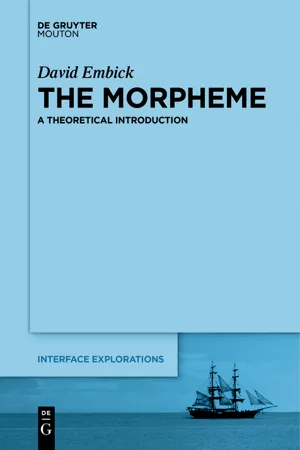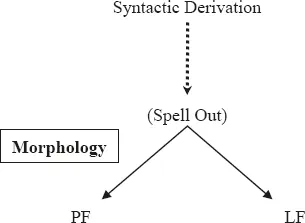
This is a test
- 261 pages
- English
- ePUB (mobile friendly)
- Available on iOS & Android
eBook - ePub
The Morpheme
Book details
Book preview
Table of contents
Citations
About This Book
This book develops a theory of the morpheme in the framework of Distributed Morphology. Particular emphasis is devoted to the way in which functional morphemes receive their phonological form post-syntactically, through the operation of Vocabulary Insertion. In addition to looking closely at syncretism, the primary motivation for Vocabulary Insertion, the book examines allomorphy, blocking, and other key topics in the theory of the morpheme.
Frequently asked questions
At the moment all of our mobile-responsive ePub books are available to download via the app. Most of our PDFs are also available to download and we're working on making the final remaining ones downloadable now. Learn more here.
Both plans give you full access to the library and all of Perlego’s features. The only differences are the price and subscription period: With the annual plan you’ll save around 30% compared to 12 months on the monthly plan.
We are an online textbook subscription service, where you can get access to an entire online library for less than the price of a single book per month. With over 1 million books across 1000+ topics, we’ve got you covered! Learn more here.
Look out for the read-aloud symbol on your next book to see if you can listen to it. The read-aloud tool reads text aloud for you, highlighting the text as it is being read. You can pause it, speed it up and slow it down. Learn more here.
Yes, you can access The Morpheme by David Embick in PDF and/or ePUB format, as well as other popular books in Languages & Linguistics & Linguistics. We have over one million books available in our catalogue for you to explore.
Information
Chapter 1
Morphemes in the Grammar
1.1 Introduction
At the most basic level of description, a grammar consists of a set of primitive elements and a set of rules for deriving complex objects out of these primitives. According to the view that is developed in this book, the primitive elements are morphemes, and the system responsible for combining morphemes into complex structures is the syntax. The syntax generates expressions that relate sound and meaning. In the particular model of grammar that is assumed here, sound- and meaning-specific representations are created by distinct sets of computations that apply to the objects derived by the syntax. The sets of computations related to sound and meaning are referred to as Phonological Form (PF) and Logical Form (LF); these are the interfaces of the syntax.
My focus in this book is on the theory of the morpheme. This is one subpart of an area of investigation that is typically or traditionally called morphological theory. As mentioned above, the particular morphological theory that I will advance in this book starts with the assumption that morphemes are syntactic objects—i.e., the terminal nodes of syntactic derivations—and proceeds from there to develop an account of how morphemes are represented in memory, and of how they connect sound with a particular type of meaning (specifically, semantically interpreted features). Given the fundamentally syntactic orientation of this theory, it must be stressed from the outset that terms like morphology and morphological theory are used in this work in an informal sense: there are often no principled answers to questions about where “morphology” stops, and where e.g. “syntax” or “phonology” begin or end. A consequence of this view, which is emphasized throughout this book, is that it is not possible to understand the morpheme in isolation from the syntactic and phonological components of the grammar.
In terms of the model of grammar that is assumed here, there are two large questions that define research in morphological theory. The first of these is the question of the morpheme: this is the focus of the present work, and its general properties and orientation take the form sketched in the preceding paragraph. The second question concerns the rule system or systems responsible for the derivation of complex forms. This is a primary concern of morphological theory because the objects of study often consist of more than one morpheme, and it must be asked how morphemes are composed into these larger objects. In terms that are inherited from traditional grammar, the rules governing the construction of phrases are in the domain of syntax, while the rules that are responsible for the derivation of complex words are the purview of morphology or word formation. Whether or not these are truly distinct domains—i.e., whether or not the grammar of human language employs one set of computations for the derivation of words and phrases, or two—is an empirical question. On the assumption that there is some kind of derivational system at play in the generation of both words and phrases, every model of the grammar must specify whether words and phrases are derived by the same rule system, or by different systems.
The questions outlined immediately above can be stated as Q1 and Q2:
Question 1 (Q1): What is the nature of the primitive units of derivations; i.e., what is the nature of the morpheme? How do morphemes relate to syntactic, semantic, and phonological information?
Question 2 (Q2): What is the nature of the rule system that assembles morphemes into words? How does this system relate to the syntax?
The theory of the morpheme that is developed in this work assumes and articulates some specific architectural assumptions that are drawn from the framework of Distributed Morphology, which was initially presented in Halle and Marantz (1993) (building on Halle 1990); see Embick and Noyer (2007) for a short overview. With respect to Q2, Distributed Morphology takes the position that the syntax is the generative system responsible for the derivation of all complex objects; this assumption was introduced in the first paragraph of this chapter. At a number of points in this chapter and in later chapters, some additional assumptions will be made about the types of structures that are relevant for morphological concerns. However, it is not my intention in this book to consider the arguments for a syntactic approach to morphology; nor will I look in detail at the syntactic processes and structures that are implicated in the affixation of morphemes to each other. Rather, assumptions about structure are introduced only as a means of advancing the primary focus of the work, which is directed at Q1, the question of the morpheme.
To look at the morpheme in detail, it is necessary to begin with some assumptions about the organization of the grammar. Because Q1 and Q2 each implicate the relationship(s) between morphology and other components of grammatical competence—in particular, computations and representations relevant for syntax, semantics, and phonology—the study of morphology must, as pointed out above, be pursued in conjunction with a theory of how the grammar as a whole is organized. This chapter outlines the essential components of grammatical architecture in a way provides the context for an initial perspective on the morpheme.
Before considering these very general questions about the organization of the grammar, some remarks are in order concerning the “word”, an object which is often (in fact, almost always) taken to be at the center of morphological theory. The theory that is presented here posits no architectural differences between words and phrases. This means that to the extent that there is any role played by the word in the theory, both words and phrases are derived syntactically. For this reason, uses of the term “word” in the pages to come are to be understood non-technically, as a way of picking out objects which, because of their structure (and because of how the phonology interprets such structures) have the properties that linguists typically associate with (phonological) words. More precisely, the use of the term word is informal because the actual work in the theory is done by theoretical objects with technical definitions—in particular, representations that are defined in terms of morphemes, and the ways in which they are composed—that are introduced as the discussion proceeds (see in particular chapter 3). In short, even though I will follow standard practice in referring to the “word” in its familiar sense, this is a matter of convenience, nothing more.
1.2 The Architecture of the Grammar
The model of grammar that is assumed here is shown in (1). The syntactic part of the grammar generates syntactic structures, which are “spelled out” and subjected to further operations relevant to sound and meaning: these are the PF and LF interfaces respectively. For concreteness, I will speak of the derivations in (1) in terms adapted from the approach of Chomsky (2000, 2001) and related work; in principle, though, the theory of the morpheme that is advanced here is compatible with a number of different assumptions about syntactic theory.
| (1) | The Grammar |

Above, I introduced the idea that the primitive elements of syntactic derivations are morphemes. In terms of (1), this means that morphemes are the terminal nodes in the syntactic derivations that appear at the top of the diagram. The status of morphemes as basic objects—that is, in what form(s) they are represented as primitives in memory—is a matter of central importance in the theory of morphology. The basic representation of morphemes does not, however, exhaust what there is to be said about morphology and its connections with other components of the grammar, as can be seen from the presence of the Morphology box in (1). This box stands proxy for a set of computations that apply to the output of syntactic derivations, in the PF component of the grammar. With reference to (1), then, the primary goals of this book are to present (i) a theory of the basic representation of morphemes, along with (ii) a theory of the computations and representations in the Morphology box that are most relevant to the theory of the morpheme.
Some further comments are required with respect to the second of these goals. PF serves as an interface between syntax and sound-related cognitive systems.1 Among the computations that apply to serve this purpose, there are some that are primarily morphological in nature, while there are others that serve a more general purpose. For example, one operation that applies in the PF branch of the grammar adds phonological content to syntactic nodes. It is called Vocabulary Insertion, and it is examined in detail in chapter 4. This operation is specifically “morphological” in the sense that I intend here: its sole function is to supply a sound form to (certain) morphemes. On the other hand, other PF operations have a much more general character. For example, th...
Table of contents
- Cover
- Title Page
- Copyright Page
- Contents
- Chapter Dependencies
- Preface
- 1 Morphemes in the Grammar
- 2 Morphemes and Features
- 3 Structures and Linear Order
- 4 Vocabulary Insertion: An Introduction
- 5 Syncretism and (Under)specification
- 6 Further Topics in the Analysis of Syncretism
- 7 Contextual Allomorphy, and Blocking
- 8 Concluding Remarks
- Appendix: Fusion and Fission
- Notes
- Bibliography
- Index